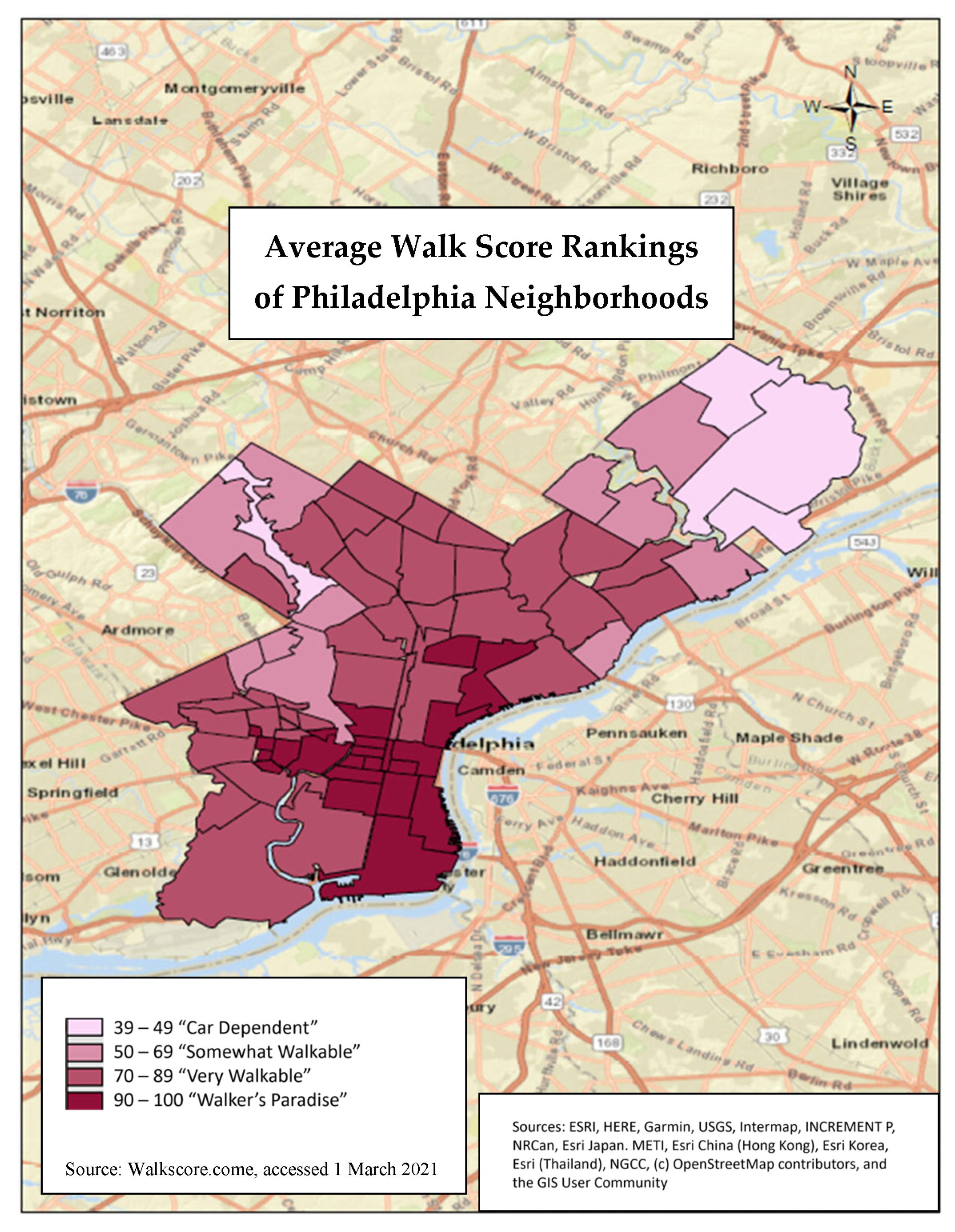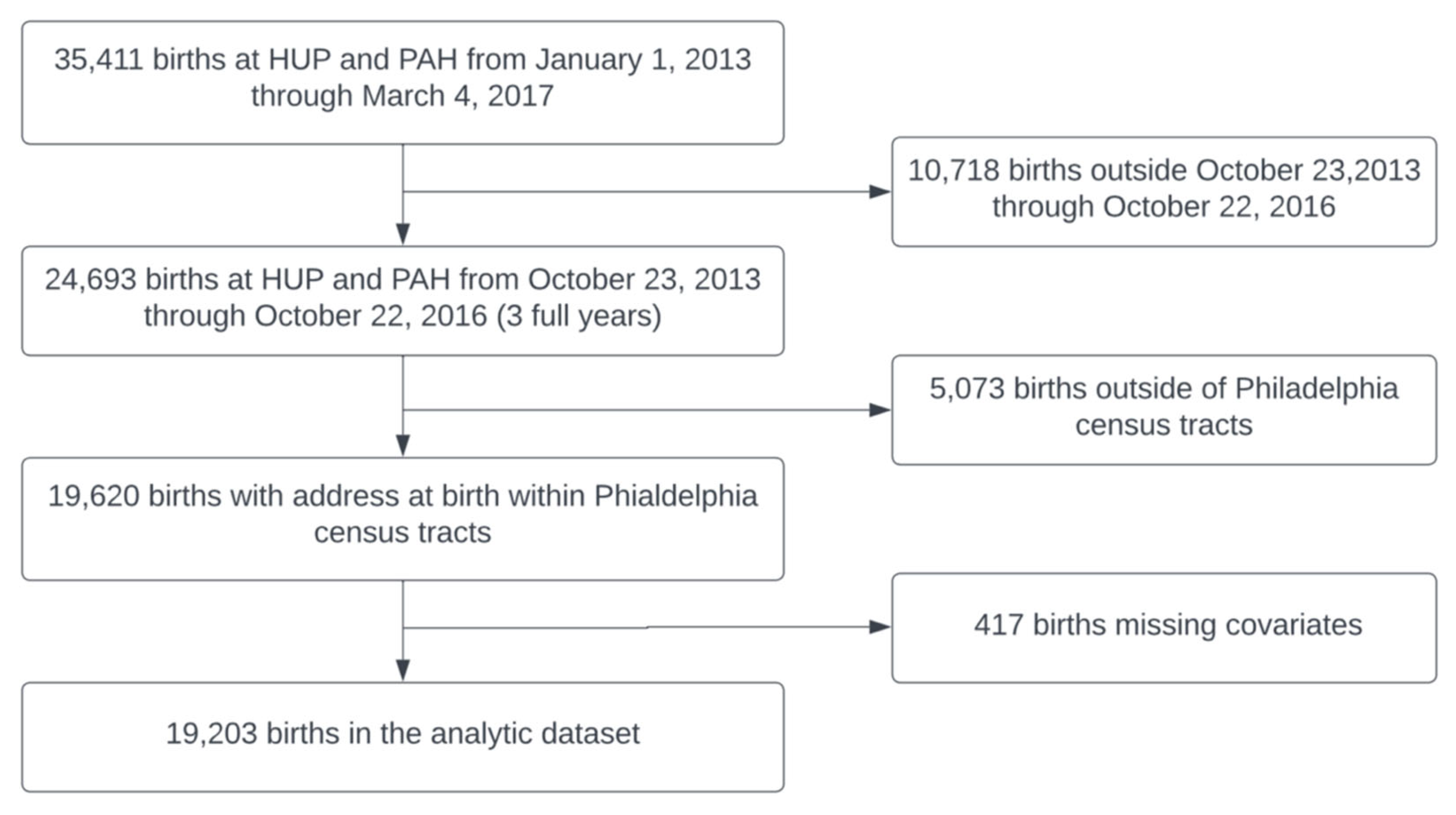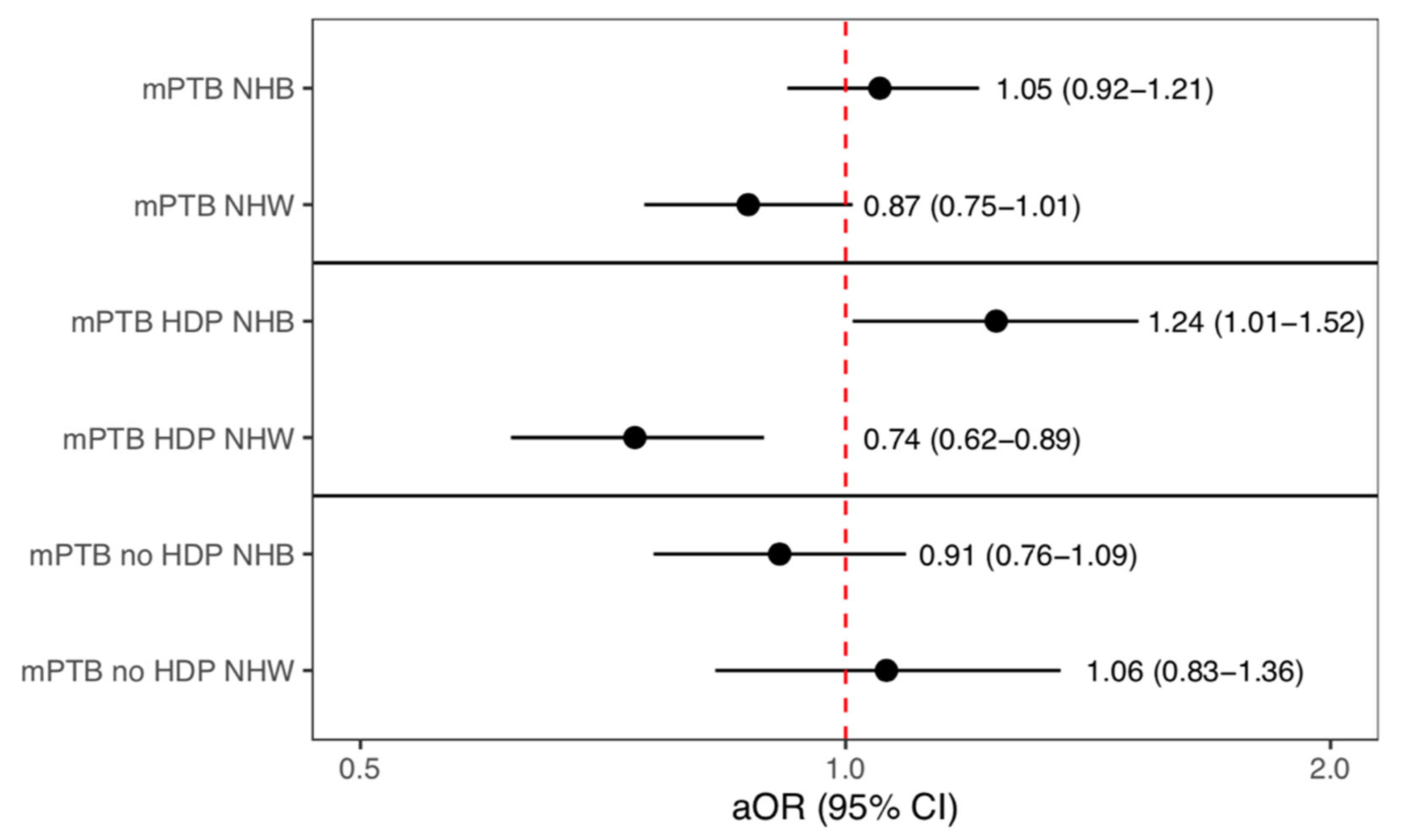Neighborhood Walkability as a Risk Factor for Preterm Birth Phenotypes in Two Philadelphia Hospitals from 2013–2016
Abstract
1. Introduction
2. Materials and Methods
2.1. Study Population
2.2. Exposure—Walkability
2.3. Outcome—PTB, sPTB and mPTB
2.4. Covariate Ascertainment
2.5. Statistical Analysis
3. Results
3.1. Study Population
3.1.1. Bivariate Associations of Demographics with Walkability
3.1.2. Bivariate Associations with PTB
3.1.3. Adjusted Associations of Walkability with PTB
4. Discussion
Strengths and Limitations
5. Conclusions
Author Contributions
Funding
Institutional Review Board Statement
Informed Consent Statement
Data Availability Statement
Acknowledgments
Conflicts of Interest
Appendix A
| n (%) | Walk Score Ranking † | Unadjusted OR (95% CI) | Adjusted a OR (95%CI) | |
|---|---|---|---|---|
| All | ||||
| Term | 17,477 (91.0) | 85.0 (9.7) | Ref. | Ref. |
| PTB | 1726 (9.0) | 84.5 (8.5) | 0.96 (0.92, 1.00) | 0.99 (0.94, 1.03) |
| sPTB | 1070 (5.6) | 84.9 (8.2) | 1.02 (0.94, 1.09) | 1.04 (0.97, 1.12) |
| mPTB | 656 (3.4) | 83.7 (9.0) | 0.88 (0.82, 0.95) * | 0.90 (0.83, 0.98) * |
| HDP | 293 (1.5) | 83.67 (9.1) | 0.88 (0.79, 0.98) * | 0.91 (0.80, 1.03) |
| Other reasons | 359 (1.9) | 83.73 (8.9) | 0.89 (0.80, 0.98) * | 0.91 (0.81, 1.01) |
| Asian, Hispanic, other, & multiracial | ||||
| Term | 3394 (92.6) | 86.9 (10.2) | Ref. | Ref. |
| PTB | 270 (7.4) | 87.2 (9.4) | 1.03 (0.91, 1.15) | 1.06 (0.94, 1.18) |
| sPTB | 187 (5.1) | 87.4 (8.6) | 1.05 (0.90, 1.22) | 1.10 (0.93, 1.29) |
| mPTB | 83 (2.3) | 86.7 (11.0) | 0.97 (0.78, 1.22) | 0.99 (0.79, 1.24) |
| HDP | 27 (0.8) | 87.5 (10.9) | 1.02 (0.66, 1.57) | 1.12 (0.73, 1.74) |
| Other reasons | 56 (1.5) | 86.4 (11.1) | 0.94 (0.71, 1.25) | 0.95 (0.72, 1.25) |
| Non-Hispanic Black | ||||
| Term | 9065 (88.9) | 82.4 (7.3) | Ref. | Ref. |
| PTB | 1130 (11.1) | 82.8 (6.8) | 0.98 (0.91, 1.05) | 0.99 (0.91, 1.08) |
| sPTB | 667 (6.6) | 82.9 (6.6) | 1.11 (0.99, 1.25) | 1.09 (0.96, 1.22) |
| mPTB | 463 (4.5) | 82.7 (6.9) | 1.06 (0.93, 1.21) | 1.05 (0.92, 1.21) |
| HDP | 215 (2.1) | 83.4 (6.7) | 1.22 (1.00, 1.50) | 1.24 (1.01, 1.52) |
| Other reasons | 244 (2.4) | 82.1 (7.2) | 0.95 (0.80, 1.12) | 0.91 (0.76, 1.09) |
| Non-Hispanic White | ||||
| Term | 5018 (93.9) | 88.3 (11.6) | Ref. | Ref. |
| PTB | 326 (6.1) | 87.9 (11.4) | 0.98 (0.91, 1.05) | 0.99 (0.91, 1.08) |
| sPTB | 216 (4.0) | 89.1 (10.1) | 1.07 (0.94, 1.22) | 1.08 (0.94, 1.24) |
| mPTB | 110 (2.1) | 85.7 (13.3) | 0.85 (0.74, 0.98) * | 0.87 (0.75, 1.01) |
| HDP | 51 (1.0) | 82.9 (15.0) | 0.75 (0.63, 0.90) * | 0.74 (0.62, 0.89) * |
| Other reasons | 59 (1.1) | 88.0 (11.1) | 0.98 (0.79, 1.22) | 1.06 (0.83, 1.36) |
References and Note
- Passini, R.; Cecatti, J.G.; Lajos, G.J.; Tedesco, R.P.; Nomura, M.L.; Dias, T.Z.; Haddad, S.M.; Rehder, P.M.; Pacagnella, R.C.; Costa, M.L.; et al. Brazilian multicentre study on preterm birth (EMIP): Prevalence and factors associated with spontaneous preterm birth. PLoS ONE 2014, 9, e109069. [Google Scholar] [CrossRef]
- Burris, H.H.; Hacker, M.R. Birth outcome racial disparities: A result of intersecting social and environmental factors. Semin. Perinatol. 2017, 41, 360–366. [Google Scholar] [CrossRef] [PubMed]
- Burris, H.H.; Lorch, S.A.; Kirpalani, H.; Pursley, D.W.M.; Elovitz, M.A.; Clougherty, J.E. Racial disparities in preterm birth in USA: A biosensor of physical and social environmental exposures. Arch. Dis. Child. 2019, 104, 931–935. [Google Scholar] [CrossRef]
- Mayne, S.L.; Yellayi, D.; Pool, L.R.; Grobman, W.A.; Kershaw, K.N. Racial Residential Segregation and Hypertensive Disorder of Pregnancy among Women in Chicago: Analysis of Electronic Health Record Data. Am. J. Hypertens. 2018, 31, 1221–1227. [Google Scholar] [CrossRef] [PubMed]
- Ananth, C.V.; Friedman, A.M.; Goldenberg, R.L.; Wright, J.D.; Vintzileos, A.M. Association between Temporal Changes in Neonatal Mortality and Spontaneous and Clinician-Initiated Deliveries in the United States, 2006–2013. JAMA Pediatr. 2018, 172, 949–957. [Google Scholar] [CrossRef] [PubMed]
- Krieger, N.; van Wye, G.; Huynh, M.; Waterman, P.D.; Maduro, G.; Li, W.; Gwynn, R.C.; Barbot, O.; Bassett, M.T. Structural racism, historical redlining, and risk of preterm birth in New York City, 2013–2017. Am. J. Public. Health 2020, 110, 1046–1053. [Google Scholar] [CrossRef]
- Masho, S.W.; Munn, M.S.; Archer, P.W. Multilevel factors influencing preterm birth in an urban setting. Urban Plan. Transp. Res. 2014, 2, 36–48. [Google Scholar] [CrossRef]
- Ahern, J.; Pickett, K.E.; Selvin, S.; Abrams, B. Preterm birth among African American and white women: A multilevel analysis of socioeconomic characteristics and cigarette smoking. J. Epidemiol. Community Health 2003, 57, 606–611. [Google Scholar] [CrossRef]
- Howell, N.A.; Tu, J.V.; Moineddin, R.; Chu, A.; Booth, G.L. Association Between Neighborhood Walkability and Predicted 10-Year Cardiovascular Disease Risk: The CANHEART (Cardiovascular Health in Ambulatory Care Research Team) Cohort. J. Am. Heart Assoc. 2019, 8, e013146. [Google Scholar] [CrossRef]
- Vinikoor-Imler, L.C.; Messer, L.C.; Evenson, K.R.; Laraia, B.A. Neighborhood conditions are associated with maternal health behaviors and pregnancy outcomes. Soc. Sci. Med. 2011, 73, 1302–1311. [Google Scholar] [CrossRef]
- Crowder, J.A. The Case for Housing Justice in Philadelphia. 2020. Available online: https://www.policylink.org/sites/default/files/pl_report_phila-housing_092520_a.pdf (accessed on 31 March 2023).
- Moye, R.; Thomas, M. Race and Housing Values: What Happens When Whites Don’t All Move Out? City Community 2018, 17, 109–133. [Google Scholar] [CrossRef]
- Environmental Systems Research Institute (ESRI). ArcGIS Street Map Premium North America Version 2021.1. Available online: https://my.esri.com/#/downloads/ArcGISStreetMapPremiumNorthAmerica/2021.1 (accessed on 31 March 2023).
- U.S. Census Bureau. Cartographic Boundaries. 2019. Available online: https://www.census.gov/geographies/mapping-files/time-series/geo/cartographic-boundary.2019.html (accessed on 31 March 2023).
- Walk Score. Philadelphia Neighborhoods. 2021. Available online: https://www.walkscore.com/PA/Philadelphia (accessed on 1 March 2021).
- Walk Score. Walk Score Methodology. 2021. Available online: https://www.walkscore.com/how-it-works/ (accessed on 1 March 2021).
- Environmental Systems Research Institute (ESRI). OpenStreetMap ArcGIS. 2021.
- Handley, S.C.; Mullin, A.M.; Elovitz, M.A.; Gerson, K.D.; Montoya-Williams, D.; Lorch, S.A.; Burris, H.H. Changes in Preterm Birth Phenotypes and Stillbirth at 2 Philadelphia Hospitals during the SARS-CoV-2 Pandemic, March–June 2020. JAMA—J. Am. Med. Assoc. 2021, 325, 87–89. [Google Scholar] [CrossRef] [PubMed]
- Date, E.D. Method for Estimating Due Date Committee on Obstetric Practice American Institute of Ultrasound in Medicine Society for Maternal-Fetal Medicine. Replace. Comm. Opin. Number. 2014, 700, 1–4. [Google Scholar]
- Brokamp, C.; Beck, A.F.; Goyal, N.K.; Ryan, P.; Greenberg, J.M.; Hall, E.S. Material Community Deprivation and Hospital Utilization During the First Year of Life: An Urban Population-Based Cohort Study. Ann. Epidemiol. 2019, 30, 37–43. [Google Scholar] [CrossRef]
- Tingley, D.; Yamamoto, T.; Hirose, K.; Keele, L.; Imai, K. Mediation: R package for causal mediation analysis. J. Stat. Softw. 2014, 59, 1–38. [Google Scholar] [CrossRef]
- The American College of Obstetricians and Gynecologists. Physical Activity and Exercise during Pregnancy and the Postpartum PEriod. 2020. Available online: https://www.acog.org/clinical/clinical-guidance/committee-opinion/articles/2020/04/physical-activity-and-exercise-during-pregnancy-and-the-postpartum-period (accessed on 6 January 2022).
- Magro-Malosso, E.R.; Saccone, G.; Di Tommaso, M.; Roman, A.; Berghella, V. Exercise during pregnancy and risk of gestational hypertensive disorders: A systematic review and meta-analysis. Acta Obstet. Gynecol. Scand. 2017, 96, 921–931. [Google Scholar] [CrossRef]
- Carr, L.J.; Dunsiger, S.I.; Marcus, B.H. Validation of Walk Score for estimating access to walkable amenities. Br. J. Sports Med. 2011, 45, 1144–1148. [Google Scholar] [CrossRef]
- Gaskin, D.J.; Dinwiddie, G.Y.; Chan, K.S.; McCleary, R. Residential segregation and disparities in health care services utilization. Med. Care Res. Rev. 2012, 69, 158–175. [Google Scholar] [CrossRef]
- United States Department of Agriculture. Access to Affordable and Nutritious Food Measuring and Understanding Food Deserts and Their Consequences; United States Department of Agriculture: Washington, DC, USA, 2009. [Google Scholar]
- Beaulac, J.; Kristjansson, E.; Cummins, S. A systematic review of food deserts, 1966–2007. Prev. Chronic Dis. 2009, 6, A105. [Google Scholar]
- Duncan, D.T.; Aldstadt, J.; Whalen, J.; White, K.; Castro, M.C.; Williams, D.R. Space, race, and poverty: Spatial inequalities in walkable neighborhood amenities? Demogr. Res. 2012, 26, 409. [Google Scholar] [CrossRef] [PubMed]
- Krivo, L.J.; Peterson, R.D.; Kuhl, D.C. Segregation, racial structure, and neighborhood violent crime. Am. J. Sociol. 2009, 114, 1765–1802. [Google Scholar] [CrossRef] [PubMed]
- Bennett, G.G.; McNeill, L.H.; Wolin, K.Y.; Duncan, D.T.; Puleo, E.; Emmons, K.M. Safe to walk? Neighborhood safety and physical activity among public housing residents. PLoS Med. 2007, 4, e306. [Google Scholar] [CrossRef]
- Sealy-Jefferson, S.; Giurgescu, C.; Slaughter-Acey, J.; Caldwell, C.; Misra, D. Neighborhood Context and Preterm Delivery among African American Women: The Mediating Role of Psychosocial Factors. J. Urban. Health 2016, 93, 984–996. [Google Scholar] [CrossRef] [PubMed]
- Agency for Toxic Substances and Disease Registry. Social Vulnerability Index. 2022. Available online: https://www.atsdr.cdc.gov/placeandhealth/svi/index.html (accessed on 31 March 2023).
- Kind, A.J.H.; Buckingham, W.R. Making Neighborhood-Disadvantage Metrics Accessible—The Neighborhood Atlas. N. Engl. J. Med. 2018, 378, 2456. [Google Scholar] [CrossRef] [PubMed]
- Hirsch, J.A.; Grengs, J.; Schulz, A.; Adar, S.D.; Rodriguez, D.A.; Brines, S.J.; Roux, A.V.D. How much are built environments changing, and where?: Patterns of change by neighborhood sociodemographic characteristics across seven U.S. metropolitan areas. Soc. Sci. Med. 2016, 169, 97–105. [Google Scholar] [CrossRef]



| Total (n = 19,203) | Term (n = 17,477) | PTB (n = 1726) | sPTB (n = 1070) | mPTB (n = 656) | ||||
|---|---|---|---|---|---|---|---|---|
| Charcteristics | n (%) | n (%) | n (%) | p a | n (%) | p a | n (%) | p a |
| Age (years) | 0.0275 * | <0.0001 * | 0.0133 * | |||||
| <25 | 5213 (27.1) | 4700 (26.9) | 513 (29.7) | 361 (33.7) | 152 (23.2) | |||
| 25-<35 | 10,579 (55.1) | 9675 (55.4) | 904 (52.4) | 542 (50.7) | 362 (55.2) | |||
| ≥35 | 3411 (17.8) | 3102 (17.7) | 309 (17.9) | 167 (15.6) | 142 (21.6) | |||
| Race/ethnicity b | <0.0001 * | <0.0001 * | <0.0001 * | |||||
| Non-Hispanic White | 5344 (27.8) | 5018 (28.7) | 326 (18.9) | 216 (20.2) | 110 (16.8) | |||
| Non-Hispanic Black | 10,195 (53.1) | 9065 (51.9) | 1130 (65.5) | 667 (62.3) | 463 (70.6) | |||
| Asian | 1191 (6.2) | 1112 (6.4) | 79 (4.6) | 64 (6.0) | 15 (2.3) | |||
| Hispanic | 1618 (8.4) | 1493 (8.5) | 125 (7.2) | 79 (7.4) | 46 (7.0) | |||
| Multiracial, other, unknown | 855 (4.5) | 789 (4.5) | 66 (3.8) | 44 (4.1) | 22 (3.4) | |||
| Insurance status | <0.0001 * | <0.0001 * | <0.0001 * | |||||
| Private | 8432 (43.9) | 7835 (44.8) | 597 (34.6) | 371 (34.7) | 226 (34.5) | |||
| Public/self-pay/other | 10,771 (56.1) | 9642 (55.2) | 1129 (65.4) | 699 (65.3) | 430 (65.5) | |||
| Body mass index (kg/m2) | <0.0001 * | 0.0006 * | <0.0001 * | |||||
| <25 | 7733 (40.3) | 7144 (40.9) | 589 (34.1) | 401 (37.5) | 188 (28.7) | |||
| ≥25-<30 | 3719 (19.4) | 3392 (19.4) | 327 (19.0) | 190 (17.8) | 137 (20.9) | |||
| ≥30 | 4256 (22.2) | 3776 (21.6) | 480 (27.8) | 233 (21.8) | 247 (37.7) | |||
| Missing | 3495 (18.2) | 3165 (18.1) | 330 (19.1) | 246 (23.0) | 84 (12.8) | |||
| Parity | 0.0120 * | 0.0221 * | 0.2165 | |||||
| 0 | 8494 (44.2) | 7780 (44.5) | 714 (41.4) | 438 (40.9) | 276 (42.1) | |||
| >0 | 10709 (55.8) | 9697 (55.5) | 1012 (58.6) | 632 (59.1) | 380 (57.9) | |||
| Walk Score ranking †, mean (SD) | 84.9 (9.6) | 85.0 (9.7) | 84.5 (8.5) | 0.0450 * | 84.9 (8.2) | 0.9476 | 83.7 (9.0) | 0.0012 * |
| Neighborhood deprivation index ^, mean (SD) | 0.49 (0.14) | 0.49 (0.14) | 0.51 (0.13) | <0.0001 * | 0.51 (0.13) | <0.0001 * | 0.52 (0.13) | <0.0001 * |
| Walk Score Ranking † | p a | |
|---|---|---|
| Mean (SD) | ||
| Age (years) | <0.0001 * | |
| <25 | 83.5 (7.4) | |
| 25-<35 | 85.1 (10.1) | |
| ≥ 35 | 86.6 (10.6) | |
| Race/ethnicity b | <0.0001 * | |
| Non-Hispanic White | 88.2 (11.6) | |
| Non-Hispanic Black | 82.5 (7.3) | |
| Asian | 88.2 (10.6) | |
| Hispanic | 87.2 (8.6) | |
| Multiracial, other, unknown | 84.7 (11.7) | |
| Insurance status | <0.0001 * | |
| Private | 86.4 (11.4) | |
| Public/self-pay/other | 83.8 (7.6) | |
| Body mass index (kg/m2) | <0.0001 * | |
| <25 | 86.7 (10.3) | |
| ≥25-<30 | 84.4 (9.7) | |
| ≥30 | 83.0 (8.6) | |
| Missing | 83.9 (8.3) | |
| Parity | <0.0001 * | |
| 0 | 85.7 (10.2) | |
| >0 | 84.3 (9.0) |
| Walk Score Ranking † Mean (SD) | Unadjusted OR (95% CI) | Adjusted OR a (95% CI) | Interaction p-Value | |
|---|---|---|---|---|
| All | ||||
| Term | 85.0 (9.7) | Ref. | Ref. | |
| PTB | 84.5 (8.5) | 0.96 (0.92, 1.00) | 0.99 (0.94, 1.03) | - |
| sPTB | 84.9 (8.2) | 1.02 (0.94, 1.09) | 1.04 (0.97, 1.12) | - |
| mPTB | 83.7 (9.0) | 0.88 (0.82, 0.95) * | 0.90 (0.83, 0.98) * | - |
| Asian, Hispanic, other, multiracial, and unknown | ||||
| Term | 86.9 (10.2) | Ref. | Ref. | |
| PTB | 87.2 (9.4) | 1.03 (0.91, 1.15) | 1.06 (0.94, 1.18) | 0.45 |
| sPTB | 87.4 (8.6) | 1.05 (0.90, 1.22) | 1.10 (0.93, 1.29) | 0.87 |
| mPTB | 86.7 (11.0) | 0.97 (0.78, 1.22) | 0.99 (0.79, 1.24) | 0.25 |
| Non-Hispanic Black | ||||
| Term | 82.4 (7.3) | Ref. | Ref. | |
| PTB | 82.8 (6.8) | 0.98 (0.91, 1.05) | 0.99 (0.91, 1.08) | 0.16 |
| sPTB | 82.9 (6.6) | 1.11 (0.99, 1.25) | 1.09 (0.96, 1.22) | 0.97 |
| mPTB | 82.7 (6.9) | 1.06 (0.93, 1.21) | 1.05 (0.92, 1.21) | 0.03 * |
| Non-Hispanic White | ||||
| Term | 88.3 (11.6) | Ref. | Ref. | |
| PTB | 87.9 (11.4) | 0.98 (0.91, 1.05) | 0.99 (0.91, 1.08) | Ref. |
| sPTB | 89.1 (10.1) | 1.07 (0.94, 1.22) | 1.08 (0.94, 1.24) | Ref. |
| mPTB | 85.7 (13.3) | 0.85 (0.74, 0.98) * | 0.87 (0.75, 1.01) | Ref. |
Disclaimer/Publisher’s Note: The statements, opinions and data contained in all publications are solely those of the individual author(s) and contributor(s) and not of MDPI and/or the editor(s). MDPI and/or the editor(s) disclaim responsibility for any injury to people or property resulting from any ideas, methods, instructions or products referred to in the content. |
© 2023 by the authors. Licensee MDPI, Basel, Switzerland. This article is an open access article distributed under the terms and conditions of the Creative Commons Attribution (CC BY) license (https://creativecommons.org/licenses/by/4.0/).
Share and Cite
Kash, T.A.; Ledyard, R.F.; Mullin, A.M.; Burris, H.H. Neighborhood Walkability as a Risk Factor for Preterm Birth Phenotypes in Two Philadelphia Hospitals from 2013–2016. Int. J. Environ. Res. Public Health 2023, 20, 5932. https://doi.org/10.3390/ijerph20115932
Kash TA, Ledyard RF, Mullin AM, Burris HH. Neighborhood Walkability as a Risk Factor for Preterm Birth Phenotypes in Two Philadelphia Hospitals from 2013–2016. International Journal of Environmental Research and Public Health. 2023; 20(11):5932. https://doi.org/10.3390/ijerph20115932
Chicago/Turabian StyleKash, Theresa A., Rachel F. Ledyard, Anne M. Mullin, and Heather H. Burris. 2023. "Neighborhood Walkability as a Risk Factor for Preterm Birth Phenotypes in Two Philadelphia Hospitals from 2013–2016" International Journal of Environmental Research and Public Health 20, no. 11: 5932. https://doi.org/10.3390/ijerph20115932
APA StyleKash, T. A., Ledyard, R. F., Mullin, A. M., & Burris, H. H. (2023). Neighborhood Walkability as a Risk Factor for Preterm Birth Phenotypes in Two Philadelphia Hospitals from 2013–2016. International Journal of Environmental Research and Public Health, 20(11), 5932. https://doi.org/10.3390/ijerph20115932







